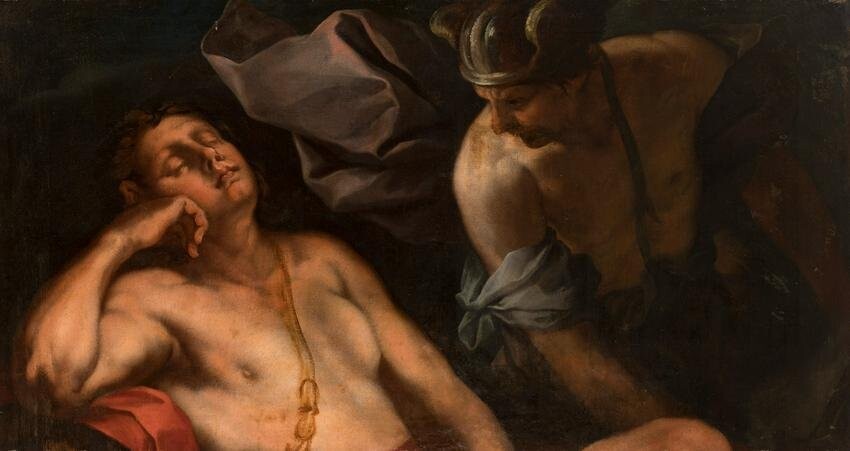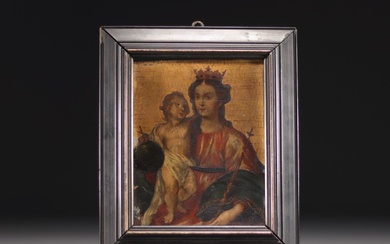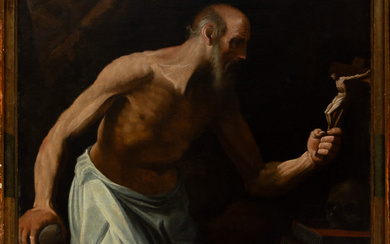Italian school; XVII century. "Mercury and Argos". Oil on canvas. It presents repainting and
Italian school; 17th century.
"Mercury and Argos".
Oil on canvas.
It has repainting and restorations.
The original canvas is preserved.
It has a 19th century frame of stuccoed wood.
Measurements: 74 x 139 cm; 90 x 155 cm (frame).
In this landscape format image, two men are the protagonists of the scene. Their classical clothes and their attitudes indicate that they are Mercury and Argos. Mercury, the messenger of the gods with his winged helmet, observing the peaceful sleep of Argos, who rests oblivious to everything. This pictorial scene is inspired by one of the myths in Ovid's Metamorphoses, which tells how Zeus' love for Io arouses the wrath of Hera. Trying to enjoy a moment alone with his new love, Zeus unleashes a fog in order not to be seen, but Hera manages to get rid of it. At this point Zeus transforms Io into a white calf, but Hera consciously decides that Argus should be her guardian. Argus, who was a giant, was remarkable for his hundred eyes, which he never closed completely, not even to sleep. Due to the situation Zeus sends Mercury to make Argus sleep. Finally, Mercury manages to make Argus close his eyes, overcome by the sleep caused by the music of his flute.
In this particular case, the figure of Argus has not faithfully followed the text, as the character is presented as a young man, without his characteristic hundred eyes. This is a resource that Velázquez, who also produced a work on this theme, was able to resolve magnificently by leaving Argos's face hidden in his hair and presenting it to the viewer in a veiled manner. Aesthetically, the work follows the stylistic precepts of the Italian school, showing a perfect anatomy of classical inspiration, with atornasolated colours, as can be seen in Mercury's cloak, etc.
View it on
Estimate
Time, Location
Auction House
Italian school; 17th century.
"Mercury and Argos".
Oil on canvas.
It has repainting and restorations.
The original canvas is preserved.
It has a 19th century frame of stuccoed wood.
Measurements: 74 x 139 cm; 90 x 155 cm (frame).
In this landscape format image, two men are the protagonists of the scene. Their classical clothes and their attitudes indicate that they are Mercury and Argos. Mercury, the messenger of the gods with his winged helmet, observing the peaceful sleep of Argos, who rests oblivious to everything. This pictorial scene is inspired by one of the myths in Ovid's Metamorphoses, which tells how Zeus' love for Io arouses the wrath of Hera. Trying to enjoy a moment alone with his new love, Zeus unleashes a fog in order not to be seen, but Hera manages to get rid of it. At this point Zeus transforms Io into a white calf, but Hera consciously decides that Argus should be her guardian. Argus, who was a giant, was remarkable for his hundred eyes, which he never closed completely, not even to sleep. Due to the situation Zeus sends Mercury to make Argus sleep. Finally, Mercury manages to make Argus close his eyes, overcome by the sleep caused by the music of his flute.
In this particular case, the figure of Argus has not faithfully followed the text, as the character is presented as a young man, without his characteristic hundred eyes. This is a resource that Velázquez, who also produced a work on this theme, was able to resolve magnificently by leaving Argos's face hidden in his hair and presenting it to the viewer in a veiled manner. Aesthetically, the work follows the stylistic precepts of the Italian school, showing a perfect anatomy of classical inspiration, with atornasolated colours, as can be seen in Mercury's cloak, etc.







